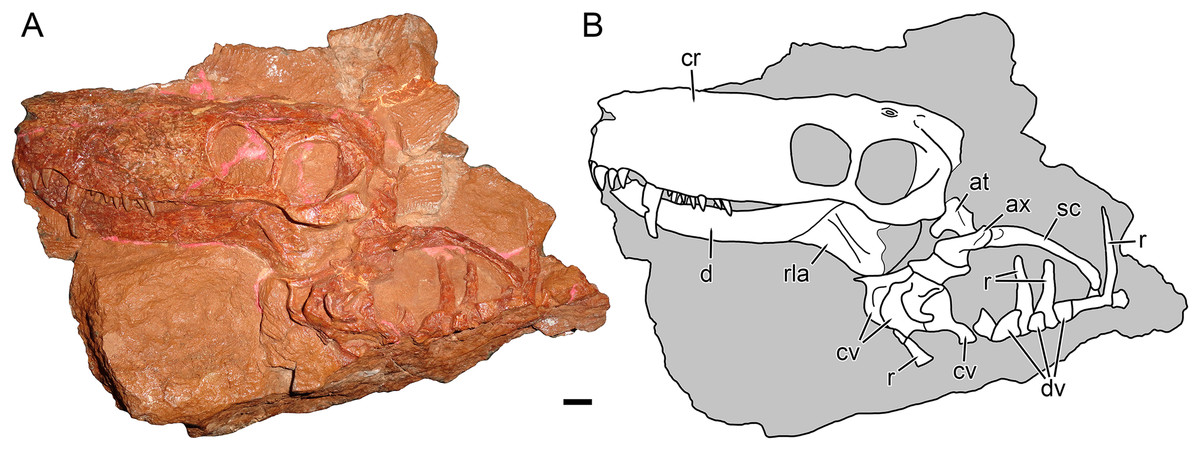Before Dinosaurs, These Creatures Ruled Earth
You wander a museum, glance at some dinosaur bones and think that one skull looks a little funny. You’ve discovered a new species.
Sure, that sounds unlikely. But that's what happened when a North Carolina paleontologist discovered two new species of protomammals, mammal-like reptiles that existed millions of years before dinosaurs, while visiting a small Russian museum.
Almost an entire skull of the saber-toothed Gorynychus sat unidentified in the Vyatka Paleontological Museum in Kirov, Russia, until Christian Kammerer, research curator of paleontology at the N.C. Museum of Natural Sciences, stopped by for a short visit.
Kammerer previously had discovered 15 new species before finding Gorynychus and Nochnitsa, the other species he identified at Vyatka.
“I would guarantee you there are thousands of undescribed species in museum collections,” Kammerer said. “Most new species are found in museum collections for the sole reason that there are literally millions of species on Earth today and many more in the fossil record. When you’re going out and collecting specimens, you won’t know those things. The people in the museum knew they were protomammals but they didn’t know they were new species."
Protomammals lived during the Permian period, which ended around 252 million years ago when a massive event killed off 90 percent of species on Earth, Kammerer said.
The new fossils prove that a smaller mid-Permian event switched up the global pecking order.
Before the mid-Permian mass extinction, Gorynychus loomed larger than Nochnitsa as the top predator. But fossils from after the extinction show that animals like Gorynychus were smaller and ate insects, while animals like Nochnitsa ruled the roost as tiger-sized saber-toothed carnivores. It’s as if bears and weasels traded sizes, Kammerer said.
“In the age before the dinosaurs, when protomammals were the dominant life on land, you had two different groups that switch off on which is the top predator,” Kammerer said. “You have wolf- to lion-sized saber tooth animals wiped out by a mass extinction, and [the Nochnitsa-like animals] take over. But [Gorynychus-like animals] aren’t wiped out altogether in this extinction, and they take over and become a small insect eating predator, not large carnivores anymore.”
It’s hard to find mid-Permian fossils. Erosion, earthquakes and volcanoes have destroyed most Permian rock. Grass, forests and water cover up much of the remaining intact rock layers.
Almost all mid-Permian fossils come from South Africa, where extremely hard volcanic rock protects lower layers from erosion. Paleontologists can reach the fossils because wind has swept off millions of years of layers above the volcanic rock, said Kirstin Brink, postdoctoral fellow at the University of British Columbia.
“It takes millions of years for a fossil to form,” Brink said. “If you were to cut open your arm, you’d find your bone is full of tiny holes. In a living animal they hold blood, bone marrow or fat. When an animal dies, that soft tissue is washed away by water or dirt.”
“The bones have to be covered by dirt or mud quickly, so they'll be protected from animals trying to eat or decomposition. Then the minerals in the dirt seep into the holes of the bone, and over millions of years those grow and look like the organic material.”
Researchers knew the top predator position swapped in South Africa, but didn’t know whether it happened globally or was a local trend.
“Until we have finds from multiple continents, it’s very hard to say what’s a global pattern and a mass extinction instead of a regional extinction,” Kammerer said. “This is really strong support that this was going on worldwide, not a fluke in the South African record.”
Kammerer and his co-author, Vladimir Masyutin of the Russian museum, named the new species after mythological Russian monsters as a nod to their origins. A vampire-like night spirit inspired Nochnitsa geminidens. The three-headed dragon Zmei Gorynych led toGorynychus masyutinae, which also refers to the person who dug up the fossil, Olga Masyutina.
People love finding new species of animals and plants. Paleontologists examine fossils to learn how animals interacted in the past, which might help us understand the future.
“We need to know what these animals looked like and where they lived to understand how our planet has changed over time,” Brink said. “For example, a lot of animals are going extinct today. Is it a local problem where animals are going extinct in one part of the world but live in another part, or is it a global thing where the animals are gone everywhere? We can use the fossil record to predict what might happen in the world today.”
Source: www.newsobserver.com









